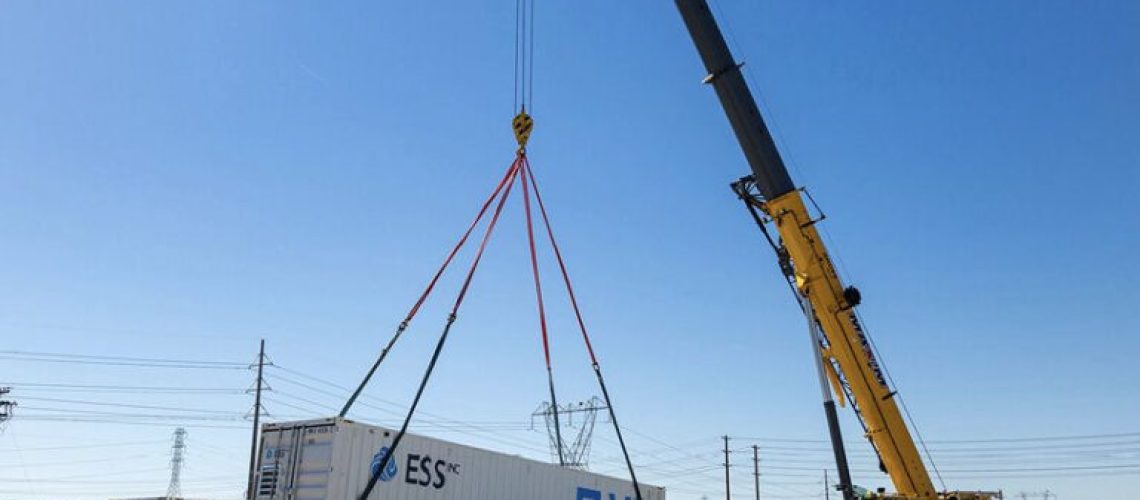There is a gap in the market for long-duration energy storage (LDES), according to US-based manufacturer ESS Inc. – one which can’t be plugged with lithium-ion chemistry. Hugh McDermott, of ESS Inc. tells pv magazine how he thinks iron flow batteries fit into the energy system of the future, as the company pursues global expansion.
From pv magazine 2/25
Think about how the power sector has developed over 150 years. There are peaker and intermediate power plants operating intermittently to meet periods of high electricity demand and there are baseload plants generating continuously. A variety of technology has been deployed to match load profiles. The generation mix is diverse.
“It’s horses for courses,” said Hugh McDermott, vice president (VP) of business development at ESS Inc. Asked about the business case for ESS Inc.’s long-duration iron-flow batteries, McDermott told pv magazine that LDES has a role and provides value “in any power market that has renewable [energy] targets.”
“Any power market that has a zero-carbon goal in place … simple physics says you cannot get there with two- and four-hour duration batteries,” he said.
Founded in 2011, US-based ESS Inc. manufactures LDES systems for utility- and commercial-scale applications. The company claims its iron flow LDES technology can store up to 12 hours of on-demand, “dispatchable” energy, has unlimited charging and discharging cycle life, and a 25-year lifespan. Unlike the lithium-ion chemistry that has dominated utility-scale energy storage deployment, ESS Inc.’s iron flow batteries can play in the baseload space, according to McDermott. “Fundamentally what we’re doing is transforming intermittent renewable energy into baseload energy,” he said.
Breaking ground
At its base in Wilsonville, Oregon, ESS Inc. has nameplate manufacturing capacity of “just shy of a gigawatt-hour” per year, according to McDermott. The senior VP added that there is potential to expand to around 6 GWh at the site, and the business has aspirations in that direction. “The pace of that will be driven by the order backlog and pipeline,” he said.
Ambition is backed by significant finance, thanks in part to a $50 million package provided by the Export-Import Bank of the United States of America and announced in June 2024.
Further afield, ESS Inc. has been making moves in Australia. The US-based company has teamed up with local business Energy Storage Industries (ESI) to establish a manufacturing operation that has successfully secured state backing. An under-construction plant has secured AUD 25 million ($15.5 million) in funding from the Queensland government, plus AUD 40 million in private capital.
When operational, the Australian plant will assemble iron flow LDES systems using battery modules, electrolyte, and other core components provided by ESS Inc., with remaining parts sourced from local supply chains, according to McDermott. Battery modules should start shipping from Oregon to Queensland in the first quarter of 2025.
ESS Inc. hopes to establish 200 MW/1.6 GWh of iron flow battery manufacturing capacity at the Australian plant by the end of 2026, expanding to 400 MW/3.2 GWh by 2029.
Next stop Europe?
Like Australia, Europe has ramped up renewables and battery energy storage system (BESS) deployment. Could ESS Inc. batteries soon be manufactured to the east of the Atlantic, too?
“Without a doubt,” said McDermott. “Whether it’s UK, whether it’s Ireland, whether it’s on the continent, without a doubt we will be, it’s only a matter of time before we have an assembly facility somewhere [in Europe].”
Deciding when and where ESS Inc. will manufacture in Europe is down to market forces, McDermott explained, and it’s likely the model will be similar to what’s been established in Australia – working in partnership with a local operation.
“It’s kind of chicken and egg,” said McDermott. “It makes sense to us that as soon as there’s enough demand, or at least visibility to the demand, we’re willing to make the investment. [In Australia] we saw strong demand and we pulled the trigger to formalize our local partnership.”
The long view
Like all new technologies, investing in LDES comes with certain risks. In McDermott’s opinion, LDES is essential to the energy transition, however, and the state can play a role in de-risking investment. He highlighted the cap-and-floor mechanism being introduced for LDES in the United Kingdom, as an example of the ways governments can support energy storage deployment.
“For example, [the UK government] is introducing a cap-and-floor mechanism to incentivize investment in long-duration energy storage,” he said. Incentives and structures are needed for newer technology to help overcome a perceived technology risk for investors.
Iron flow batteries, at least, are not completely new technology. McDermott highlighted existing ESS Inc. installations in multiple markets as proof of concept. The company has already delivered a 1 MW/10 MWh iron flow battery to a site next to Stanwell Power Station, in a deal with Queensland’s state-owned energy generation business Stanwell Corp.
Closer to home, ESS Inc. has a partnership with global conglomerate Honeywell. That deal, which was first announced in 2023, saw Honeywell purchase $27.5 million of ESS Inc. company stock. It also provided ESS Inc. with access to Honeywell’s flow battery intellectual property as well as a business relationship with a big potential customer. McDermott said the design phase of a major project for Honeywell was finishing up at around the end of 2024. The goal is to develop a design that can be deployed for gigawatt-scale installations.



